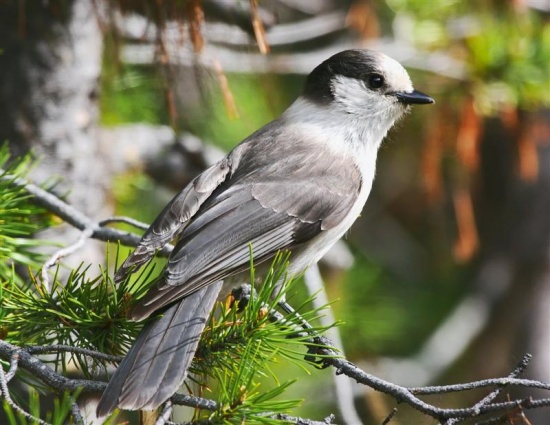
Photo by digitalbirder
Manning Park forest, British Columbia, Canada, 11 May, 2005
Alternative name: Gray Jay
- Perisoreus canadensis
Identification
27 - 31cm. A small, variable jay of the forest of North America. Generally small-billed and with a fluffy appearance.
- Nominate subspecies:
- White to light greyish-white forehead, forecrown, face, neck and upper breast
- Black to dark brown central crown to nape
- Slate-grey upperparts
- Light grey underparts
- capitalis:
- paler, with a much paler head than nominate
- obscurus:
- dark on head extends to forecrown
- contrastingly dark above and pale below
The other subspecies are intermediate between the three mentioned. Sexes similar, males larger than females. Juveniles are much darker than adults.
Similar species
Looks superficially similar to Clark's Nutcracker.
Distribution
North America:
Canada: Alberta, British Columbia, Manitoba, New Brunswick, Newfoundland, Labrador, Nova Scotia, Northwest Territories, Ontario, Prince Edward Island
United States: Alaska, Arizona, California, Colorado, Idaho, Massachusetts, Maine, Michigan, Minnesota, Missouri, Montana, New Hampshire, New Jersey, New Mexico, New York, Oklahoma, Oregon, South Dakota, Utah, Vermont, Washington, Wisconsin, Wyoming
Taxonomy

Photo by Glen Tepke
Mount Jefferson, White Mountain National Forest, New Hampshire, USA, 6 June, 2004
Subspecies
There are 8 subspecies[1]:
Canadensis Group - Gray Jay (Northern)
- P. c. pacificus:
- central Alaska through southwestern Alaska, USA, to central-coastal British Columbia, Canada
- P. c. canadensis:
- P. c. albescens:
- western Canada east of the Rocky Mountains from northeastern British Columbia and northwestern Alberta south to north central United States (Black Hills, western South Dakota)
- P. c. nigricapillus:
- Eastern Canada (northern Quebec to Newfoundland and Nova Scotia)
Gray Jay (Rocky Mountains)
- P. c. bicolor:
- Rocky Mountains from southeastern British Columbia and southwestern Alberta (Canada) south to eastern Washington, central Idaho, and western Montana (USA)
- P. c. capitalis:
- Rocky Mountains of western United States (central Idaho and southern Montana to northern New Mexico, also disjunctly in east central Arizona)
obscurus Group - Gray Jay (Pacific)
- P. c. griseus:
- South-western British Columbia and Vancouver Island to north-eastern California
- P. c. obscurus:
- Coastal north-western US (Washington to north-western California)
Habitat
Coniferous and mixed forest of the taiga and high mountain elevations. Recorded at 2440 - 3050m in the Rocky Mountains.
Behaviour
They travel in small flocks and are very tame and often approach people.
Diet
Feeds on beetles, bugs, other insects, spiders, berries, fungi and sometimes on small birds, frogs, snakes, mice or other vertebrates. Takes also carrion. Produces a sticky saliva with which it glues together berries and other food items into balls for easier winter storage, like its relative the Siberian Jay.
Breeding
Breeding season starts already in late winter (February) and goes to April. Two birds stay permanently together. The nest is a bulky platform made of twigs and well insulated. It's placed 1.7 to 15m above the ground, close to the trunk of a spruce or fir tree. Lays 3 - 4 eggs.
Movements
A resident species. Most pairs stay in their territory for their whole life.
References
- Clements, J. F., P. C. Rasmussen, T. S. Schulenberg, M. J. Iliff, T. A. Fredericks, J. A. Gerbracht, D. Lepage, A. Spencer, S. M. Billerman, B. L. Sullivan, and C. L. Wood. 2023. The eBird/Clements checklist of Birds of the World: v2023. Downloaded from https://www.birds.cornell.edu/clementschecklist/download/
- Avibase
- Del Hoyo, J, A Elliott, and D Christie, eds. 2009. Handbook of the Birds of the World. Volume 14: Bush-shrikes to Old World Sparrows. Barcelona: Lynx Edicions. ISBN 978-8496553507
Recommended Citation
- BirdForum Opus contributors. (2025) Canada Jay. In: BirdForum, the forum for wild birds and birding. Retrieved 11 May 2025 from https://www.birdforum.net/opus/Canada_Jay
External Links
GSearch checked for 2020 platform.1





